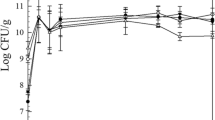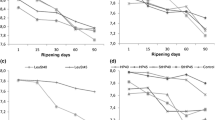Abstract
The behaviour of two combined starter cultures and their influence on the microbiological and physicochemical characteristics of dry-cured ham have been evaluated. Three lots of dry-cured hams were tested during processing (0, 9, 48, 74, 112, 142, 166 and 211 days). Lot 1 had no added starter culture. Lot 2 contained a starter culture of Penicillium chrysogenum, Penicillium digitatum, Penicillium nalgiovense, Debaryomyces hansenii, Lactobacillus plantarum, Lactobacillus acidophilus, Pediococcus pentosaceus and Micrococcus varians was and lot 3 had L. plantarum, L. acidophilus, P. pentosaceus and M. varians. The use of a selected starter culture based on a combination of lactic acid bacteria (LAB) and fungal strains with a demonstrated proteolytic activity such as P. chrysogenum and D. hansenii (lot 2) did not affect the main characteristics of dry-cured ham processing, even enhancing some desirable aspects, like its non-protein nitrogen contents. LAB strains were not significantly affected by combining them with fungal starter, and better counts were found with respect to control. A higher thiobarbituric acid reactive substances content was described in lot inoculated only with LAB (lot 3). Potentially pathogenic microorganisms were not detected in any of the lots studied. The starter culture used in lot 2 showed a potential interest for use in dry-cured ham production.
Similar content being viewed by others
References
Acosta R, Rodríguez-Martín A, Martín A, Núñez F, Asensio MA (2009) Selection of antifungal protein-producing molds from dry-cured meat products. Int J Food Microbiol 135:39–46. https://doi.org/10.1016/j.ijfoodmicro.2009.07.020
Andrade MJ, Thorsen L, Rodríguez A, Córdoba JJ, Jespersen L (2014) Inhibition of ochratoxigenic moulds by Debaryomyces hansenii strains for biopreservation of dry-cured meat products. Int J Food Microbiol 170:70–77. https://doi.org/10.1016/j.ijfoodmicro.2013.11.004
AOAC (1990) Official methods of analysis of Association of Official Analytical Chemists (AOAC), 15th edn. Association of Official Analytical Chemists, Arlington
Arnau J, Hugas M, Monfort JM (1987) Jamón curado: aspectos técnicos. Grafis-Sant, Girona
Arnau J, Guerrero L, Sarraga C (1998) The effect of green ham pH and NaCl concentration on cathepsin activities and the sensory characteristics of dry-cured hams. J Sci Food Agric 77:387–392
Asefa DT, Gjerde RO, Sidhu MS, Langsrud S, Kure CF, Nesbakken T, Skaar I (2009) Moulds contaminants on Norwegian dry-cured meat products. Int J Food Microbiol 128(3):435–439. https://doi.org/10.1016/j.ijfoodmicro.2008.09.024
Bandeira C, Barranco A, Ciudad N, Fontes E, Galán H, León F, Moreno R, Penedo JC, Peralta A (1990) Técnicas analíticas de control de calidad en las industrias cárnicas. Litopress, Córdoba
Battilani P, Pietri VA, Giorni P, Formenti S, Bertuzzi T, Toscani T, Virgili R, Kozakiewics Z (2007) Penicillium populations in dry-cured ham manufacturing plants. J Food Prot 70:975–980
Bosse Née Danz R, Müller A, Gibis M, Weiss A, Schmidt H, Weiss J (2018) Recent advances in cured raw ham manufacture. Crit Rev Food Sci Nutr 58(4):610–630. https://doi.org/10.1080/10408398.2016.1208634
Casaburi A, Di Monaco R, Cabella S, Toldrá F, Ercolini D, Villani F (2008) Proteolitic and lipolitic starter cultures and their effect on traditional fermented sausages ripening and sensory traits. Food Microbiol 25:335–347. https://doi.org/10.1016/j.fm.2007.10.006
Fadda S, López C, Vignolo G (2010) Role of lactic acid bacteria during meat conditioning and fermentation: peptides generated as sensorial and hygienic biomarkers. Meat Sci 86:66–79. https://doi.org/10.1016/j.meatsci.2010.04.023
Hernández E, Huerta T (1993) Evolución de los parámetros microbiológicos del jamón curado. In: Proceedings of XIV Congreso de Microbiología SEM; Zaragoza, Spain, 8–11 September 1993, pp 10–19
Kim YJ, Park SY, Lee HC, Yoo SS, Oh S, Kim KH, Chin KB (2016) Evaluation of mixed probiotic starter cultures isolated from kimchi on physicochemical and functional properties, and volatile compounds of fermented hams. Korean J Food Sci Anim Resour 36(1):122–130. https://doi.org/10.5851/kosfa.2016.36.1.122
Laranjo M, Elias M, Fraqueza MJ (2017) The use of starter cultures in traditional meat products. Food Qual. https://doi.org/10.1155/2017/9546026
López MC, Medina LM, Priego R, Jordano R (2006) Behaviour of the constitutive biota of two Spanish dry-sausages ripened in a pilot-scale chamber. Meat Sci 73:178–180. https://doi.org/10.1016/j.meatsci.2005.10.014
Martín A (1999) Contribución de la población fúngica seleccionada al desarrollo de características deseables del jamón curado. Doctoral Thesis, Extremadura University, Cáceres, Spain
Martín A, Ruiz J, Núñez F, Córdoba JJ, Asensio MA (2000) Contribución de la población microbiana a la seguridad y calidad del jamón curado. In: Monfort JM (ed) II Symposium Internacional del Jamón Curado. Eurocarne, Estrategias Alimentarias, pp 55–64
Martín A, Córdoba JJ, Benito MJ, Aranda E, Asensio MA (2003) Effect of Penicillium chrysogenum and Debaryomyces hansenii on the volatile compounds during controlled ripening of pork loins. Int J Food Microbiol 84:327–338
Martín A, Jurado M, Rodríguez M, Núñez F, Córdoba JJ (2004) Characterization of molds from dry-cured meat products and their metabolites by micellar electrokinetic capillary electrophoresis and random amplified polymorphic DNA PCR. J Food Prot 67:2234–2239
Martín A, Córdoba JJ, Aranda E, Córdoba MG, Asensio MA (2006) Contribution of a selected fungal population to the volatile compounds on dry cured ham. Int J Food Microbiol 110:8–18. https://doi.org/10.1016/j.ijfoodmicro.2006.01.031
Marušić N, Petrović M, Vidaček S, Petrak T, Medić H (2011) Characterization of traditional Istrian dry-cured ham by mean of physical and chemical analysis and volatile compounds. Meat Sci 88(4):786–790. https://doi.org/10.1016/j.meatsci.2011.02.033
Núñez F, Rodriguez MM, Cordoba JJ, Bermudez ME, Asensio MA (1996) Yeast population during ripening of dry-cured Iberian ham. Int J Food Microbiol 29:271–280
Ockerman FJ, Céspedes FJ, León F (2000) Influence of molds on flavor quality of spanish ham. J Muscle Food 11:247–259
Pérez-Palacios T, Ruiz DJ, Barat JM, Aristoy MC, Antequera T (2010) Influence of pre-cure freezing of Iberian ham on proteolytic changes throughout the ripening process. Meat Sci 85:121–126. https://doi.org/10.1016/j.meatsci.2009.12.015
Peromingo B, Núñez F, Rodríguez A, Alía A, Andrade MJ (2018) Potential of yeasts isolated from dry-cured ham to control ochratoxin A production in meat models. Int J Food Microbiol 268:73–80. https://doi.org/10.1016/j.ijfoodmicro.2018.01.006
Rodríguez M, Núñez F, Córdoba JJ, Bermúdez ME, Asensio MA (1998) Evaluation of proteolytic activity of micro-organisms isolated from dry cured ham. J Appl Microbiol 85:905–912
Rodríguez M, Martín A, Núñez F (2001) Población microbiana del jamón ibérico y su contribución en la maduración. Cultivos iniciadores. In: Ventanas J (ed) Tecnología del jamón ibérico. Ediciones Mundi-Prensa, Madrid
Sánchez F (2005) Modificaciones tecnológicas para mejorar la calidad y seguridad del jamón curado. Thesis Doctoral, Girona University, Girona, Spain
Sánchez-Molinero F, Arnau J (2008) Effect of the inoculation of a starter culture and vacuum packaging (during resting stage) on the appearance and some microbiological and physicochemical parameters of dry-cured ham. Meat Sci 79:29–38. https://doi.org/10.1016/j.meatsci.2007.07.028
Semedo-Lemsaddek T, Carvalho L, Tempera C, Fernandes MH, Fernandes MJ, Elias M, Barreto AS, Fraqueza MJ (2016) Characterization and technological features of autochthonous coagulase-negative staphylococci as potential starters for portuguese dry fermented sausages. J Food Sci 81(5):1197–1202
Sforza S, Galaverna G, Schivazappa C, Marchelli R, Dossena A, Virgili R (2006) Effect of extended aging of Parma dry-cured ham on the content of oligopeptides and free amino acids. J Agric Food Chem 54:9422–9429. https://doi.org/10.1021/jf061312+
Simoncini N, Rotelli D, Virgili R, Quintavalla S (2007) Dynamics and characterization of yeasts during ripening of typical Italian dry-cured ham. Food Microbiol 24:577–584. https://doi.org/10.1016/j.fm.2007.01.003
Simoncini N, Pinna A, Toscani T, Virgilio R (2015) Effect of added autochthonous yeasts on the volatile compounds of dry-cured hams. Int J Food Microbiol 212:25–33. https://doi.org/10.1016/j.ijfoodmicro.2015.06.024
Takeda S, Matsufuji H, Nakade K, Takenoyama S, Ahhmed A, Sakata R, Kawahara S, Muguruma M (2017) Investigation of lactic acid bacterial strains for meat fermentation and the product’s antioxidant and angiotensin-I-converting-enzyme inhibitory activities. Anim Sci J 88:507–516. https://doi.org/10.1111/asj.12673
Talon R, Leroy S, Lebert I, Giammarinaro P, Chacornac JP, Latorre-Moratalla M, Vidal-Carou C, Zanardi E, Conter M, Lebecque A (2008) Safety improvement and preservation of typical sensory qualities of traditional dry fermented sausages using autochthonous starter cultures. Int J Food Microbiol 126(1–2):227–234
Tarladgis BG, Pearson AM, Dugan LJ (1964) Chemistry of the 2-thiobarbituric acid test for determination of oxidative rancidity in foods. II. Formation of the TBA malonaldehyde complex without acid heat treatment. J Sci Food Agric 15:602–607
Toldrá F (2008) Dry cured meat products. Wiley, New York
Toledano A, Jordano R, López C, Medina LM (2011) Proteolytic activity of lactic acid bacteria strains and fungal biota for potential use as starter cultures in dry-cured ham. J Food Prot 74:826–829. https://doi.org/10.4315/0362-028X.JFP-10-471
Vilar I, Garcia MC, Prieto B, Tornadijo ME, Carballo J (2000) A survey on the microbiological changes during of the manufacture of dry cured lacón, a Spanish traditional meat product. J Appl Microbiol 89:1018–1026
Author information
Authors and Affiliations
Corresponding author
Rights and permissions
About this article
Cite this article
Toledano, A.M., Jordano, R., Medina, L.M. et al. Behavior and effect of combined starter cultures on microbiological and physicochemical characteristics of dry-cured ham. J Food Sci Technol 56, 122–131 (2019). https://doi.org/10.1007/s13197-018-3465-7
Revised:
Accepted:
Published:
Issue Date:
DOI: https://doi.org/10.1007/s13197-018-3465-7




